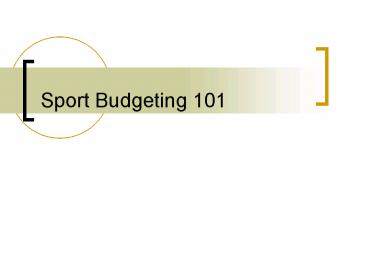Sport Budgeting 101 - PowerPoint PPT Presentation
1 / 26
Title:
Sport Budgeting 101
Description:
Chief Budget Officer at mid-size, 4-year public institution in the Midwest. ... Overseeing agency serves as 'bank' Bottom-line oriented. Account is very flexible ... – PowerPoint PPT presentation
Number of Views:116
Avg rating:3.0/5.0
Title: Sport Budgeting 101
1
Sport Budgeting 101
2
Class Outline
- Introduction
- Budget Terms
- Budgeting Processes
- Types of Accounts
- Comprehension/Monitoring
- Creating a budget
- Question and Answer
3
Learning Objectives
- The participant will
- Be able to understand basic budgeting terms by
matching terms and definitions on a worksheet - Become more knowledgeable about analyzing budget
reports by identifying mistakes and
inconsistencies on a sample budget report - Gain a better understanding of the differences
between an auxiliary account, an agency account,
and a university account by correctly identifying
the differences between the three - Gain greater comprehension of the budgeting
process by creating a sample auxiliary budget.
4
Budgets
- Working Definition
- -a plan detailing how a department
- proposes to secure and utilize financial
- resources over a specified time period
- -a financial plan that serves as an estimate
of future cost, revenues, or both - Of course
5
Another Definition
- Your budget is not really a budget, its more
like a guideline for spending. - -Chief Budget Officer at mid-size, 4-year public
institution in the Midwest.
6
Purpose of Budgeting
- Plan
- Its strategic (and required)
- Keep spending in line
- Fast track on revenue
- Goal-oriented
7
Some Things You Should (Probably) Know About Your
Budget
- How much do you know about your (departments)
budget and the institutions spending parameters? - Lets find out
8
Budget Terminology
- How conversant are you
- in budget
- Terminology?
- Lets find out
9
Budgeting Terms
- Revenue Variance
- Deferred Income Expense
- Supplies Reserve
- Fund Balance Cost Center
- Expense Reimbursements Encumbrance
- Debt Retirement Revision
- Equipment
- Appendix B
10
Budget Development Processes
- Incremental
- Zero-based
- Performance
- Formula
- Seat-of-the pants
11
Types of Accounts
- Unrestricted EG (university only)
- Auxiliary
- Agency
- Plant
- Foundation
12
Unrestricted E G
- Most departments
- Funding comes from E G
- Bottom-line oriented
- Little built-in flexibility
- Positive fund balance?
- Advantages
13
Auxiliary
- Few departments
- Funding from multiple sources
- Bottom-line less an issue
- Much flexibility
- Positive fund balance?
- Advantages
14
Agency Account
- Controlled by a department/division
- Overseeing agency serves as bank
- Bottom-line oriented
- Account is very flexible
- Positive fund balance?
- Advantages
15
Plant Account (Fund)
- Controlled by a department/division
- Funding from multiple sources
- Bottom-line oriented
- Flexibility is variable
- Positive fund balance?
- Advantages
16
Foundation
- Controlled by department/division
- Funding is through fund-raising
- Bottom-line flexibility
- Much flexibility with unrestricted funds
- Positive fund balance?
- Advantages
17
Comprehension
- Types of budgets/accounts quiz
18
Comprehension (The Sequel)
- Variance
- The difference between _________
- amounts and _________ amounts.
- Demonstration of Knowledge, Appendix E (its
unlabeled)
19
Budget Monitoring
- Checking budget reports for accuracy
- Importance
- Common Errors
- Finding Mistakes
20
Common Errors
- Spreadsheet formula errors
- Transposed data
- Data entry errors
21
Finding Mistakes
- Good accountant or business manager
- Watch for unusual monthly variances
- Column total vs. Row totals in reports
22
Locate Spreadsheet Formula Error
- FY 2004 Revenues
- Through May 31, 2004
- Budgeted Actual YTD of
- Total
- Fee Income 3,948,000 3,948,000 100.0
- Non-Fee Income
- Sales 224,447 216,879 96.6
- Membership 702,341 710,993 101.2
- Programming 257,790 256,872 99.6
- Total Non-fee Income 1,184,578 1,184,744 100.0
- Total Revenue 5,132,578 5,132,744 98.7
23
Circle Possible Errors
Line Area July Aug. Sept. Oct. Total
1600 Students 1,100 1,250 1,400 130 3,750
4000 Supplies 1,000 8,500 500 0 10,000
5100 Telephone 1,234 1,234 1,234 1,243 3,702
5200 Postage 125 200 240 190 565
6000 Travel 400 0 300 1,200 700
Total 3,859 11,184 3,674 2,763 18,717
24
Corrected
Line Area July Aug. Sept. Oct. Total
1600 Employees
4000 Supplies
5100 Telephone
5200 Postage
6000 Travel
Total
- 1,100 1,250 1,400 130
3,880 - 1,000 8,500 500 0
10,000 - 1,234 1,234 1,234 1,234
4,936 - 200 240 190
755 - 0 300 1,200
1,900 - 3,859 11,184 3,674 2,754
21,471
25
Creating a Sample Auxiliary Budget
- Take FY 2004, and create FY 2005
- Assumptions
26
References
- Kent State University Policy Register. (2004).
- Carviters Orwig. (1982). Evolution of modern
budgeting. NACUBO Journal, 24-59.































